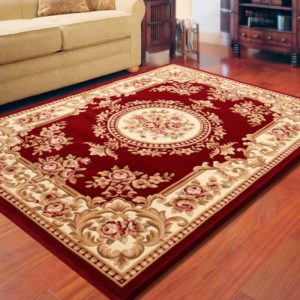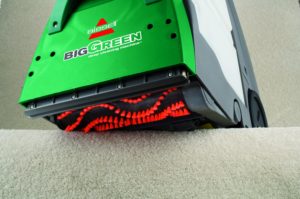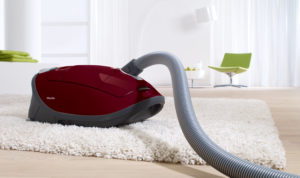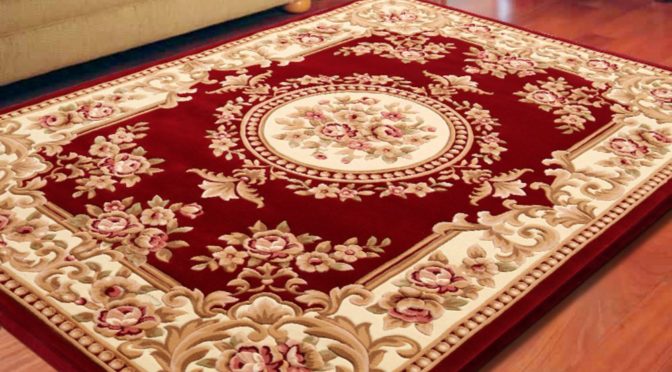
Broadloom is a term you’ll hear frequently when discussing carpet styles, but if you aren’t familiar with the ins and outs of carpets, it might sound as opaque to you as the word triextra (which refers to SmartStrand carpets, by the way). Today we’re going to look at what broadloom carpets are, how they’re sold and installed, and if there’s anything special you need to know about vacuuming them.
What does broadloom mean for carpeting and rugs?
Broadloom carpets are carpets woven with wide looms. Typically, carpets described as broadloom will be tufted and installed in a wall-to-wall style. You’ll typically buy broadloom on standard width rolls, which means rolls 12 feet wide. That said, you can also buy rolls as wide as 15 feet or beyond with special orders, and you’ll also find rolls 13 feet 6 inches wide; it depends on the machinery used and style desired.
At this point, you might be wondering what a loom is. It’s simply a tool used for fabric weaving. When weaving by hand, a loom holds the fibers that run in a given direction in place so you can interweave the fibers running in the opposite direction. This is how all carpets used to be made, and the term broadloom was a literal one that referred to a loom larger than that used on average; it was essentially a way of making wide, large carpets and rugs.
What measurements are used to sell broadloom in the US?
In the United States, you can buy broadloom carpets on widths that depend on your tastes and whatever your manufacturer of choice has chosen. A roll of broadloom will usually be around 150 feet long. You can buy broadloom by the square yard or by the square foot if you’re in North America, particularly in the United States. Canadians typically adhere to the metric system found throughout the rest of the world, but for historical reasons, they use imperial measurements when it comes to carpeting. As noted above, in other countries (i.e., most of the rest of the world), broadloom and other carpets will be sold by the square meter (or metre, if you will).
If you’re thinking in yards, keep in mind that a yard is equal to three feet, which means a square yard, or 3 feet by 3 feet, will be equivalent to nine square feet. In the past, people bought carpets by the square yard. However, when hard surface flooring came along (e.g., hardwood floors or tile), the industries that made them popularized square feet instead of square yards. As a result, the carpet industry has generally moved from square yards to square feet to get in line with current trends.
How do you install broadloom carpeting?
To install broadloom carpeting, you’ll typically use an underpad in residential applications and aim for wall-to-wall installation. In commercial settings (e.g., in office buildings), you’ll often find it directly glued to the floor. Due to the specific widths in which broadloom is sold, sometimes installations can take a bit more work when rooms aren’t exactly matched to carpet dimensions (which, as you can imagine, happens frequently).
When roll widths are narrower than room widths, broadloom pieces are typically seamed together. When rooms are narrower than rolls, carpets are cut. This isn’t technically hard to do, but you’ll still end up paying for what you cut off and ultimately don’t use. An example might involve an 11 foot by 11 foot room. If you buy a 12-foot roll of broadloom, you’d need need to buy a 12 foot by 11 foot piece of carpet and cut off the additional 11 square feet. You can sometimes take advantage of carpet remnants, although those come with advantages and disadvantages.
Alternatively, you can always cut smaller sections of broadloom, finish the edges so fraying won’t occur, and use the sections for area rugs and carpet runners. The truth is that there’s a lot of flexibility in what you can do with broadloom, so don’t limit yourself to simply buying it for wall-to-wall uses, even though it’ll work perfectly fine in a home or apartment as a general use carpet for the family.
Do you need any special vacuums or carpet cleaners to care for broadloom carpeting and rugs?

Broadloom carpets don’t necessarily need more care than any other styles of carpet, as the term again refers to the dimensions of carpet rather than any unique characteristics of the carpet itself; you’ll find broadloom carpets made from a range of materials (e.g., berber) and in a range of piles and softnesses. In general, we’d recommend a quality carpet cleaner like the Bissell 86T3 Big Green; it’ll take care of pretty much anything kids, pets, or rowdy guests can do to a carpet and is strong enough for industrial and residential work alike.

And for general day-to-day care, you can’t go wrong with our favorite carpet vacuum cleaner, the Miele Complete C3 Soft Carpet. However, as much as we love it, we want you to know that you don’t need a particular kind of vacuum cleaner to effectively clean broadloom carpeting; a Soft Carpet will just give you the flexibility to clean any carpets you come across without worrying about pile height or softness, issues that can stop many vacuums in their tracks.
![]() You can buy a beautiful European broadloom wool rug here. You can buy the Bissell 85T3 Big Green carpet cleaner here on Amazon. You can buy the Miele Complete C3 Soft Carpet here.
You can buy a beautiful European broadloom wool rug here. You can buy the Bissell 85T3 Big Green carpet cleaner here on Amazon. You can buy the Miele Complete C3 Soft Carpet here.
![]() Canadians can buy the Miele Soft Carpet here and the Bissell Big Green here.
Canadians can buy the Miele Soft Carpet here and the Bissell Big Green here.
 If you find our research on PMC helpful, you can follow our efforts to keep maniacally reviewing home cleaning tools by shopping through our links above. We promise to keep fighting the good fight against every horror children, animals, and grown, yet messy humans can inflict upon a clean home.
If you find our research on PMC helpful, you can follow our efforts to keep maniacally reviewing home cleaning tools by shopping through our links above. We promise to keep fighting the good fight against every horror children, animals, and grown, yet messy humans can inflict upon a clean home.

